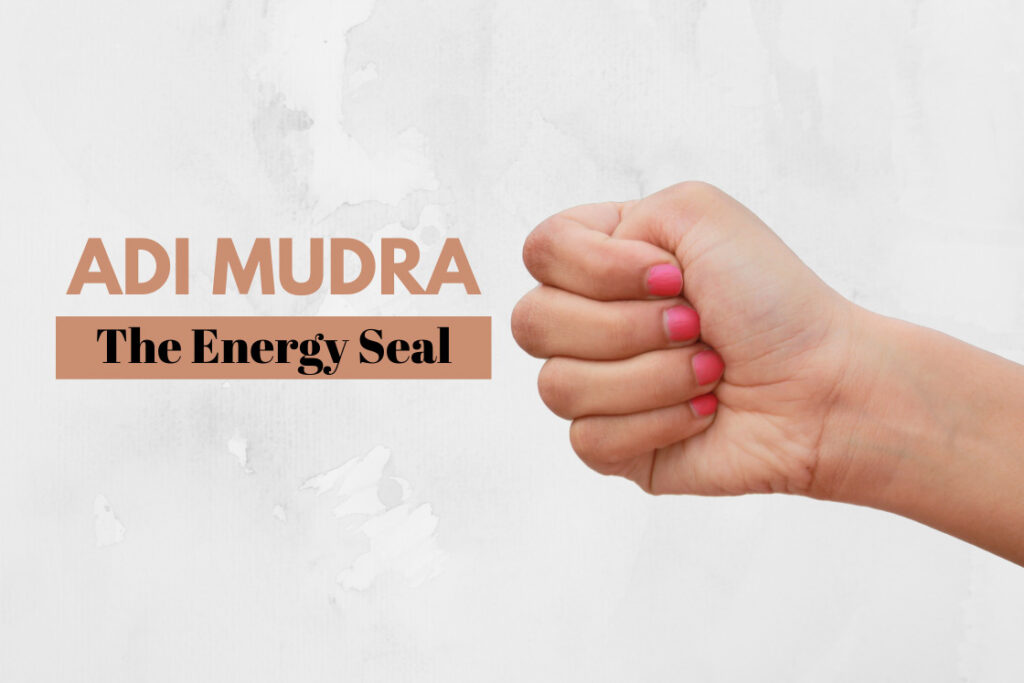Adi Mudra, known as the “primordial mudra”, is a subtle yet powerful hand gesture (hasta mudra) rooted in yogic and meditative traditions. It is often practiced during pranayama (breathwork), meditation, and restorative yoga, particularly for its calming and introspective effects.
Table of Contents
Meaning and Symbolism:
The word Adi means “first” or “primordial” in Sanskrit, and Mudra means “seal” or “gesture.” As the name suggests, this Mudra is considered one of the earliest mudras and symbolizes a return to the innate simplicity and purity of the self.
In yogic philosophy, mudras are energetic seals that influence the flow of prana (life force) within the body. Adi Mudra symbolizes withdrawal from the senses (pratyahara) and a movement toward internal awareness. The shape of the closed hand, with the thumb tucked into the palm, resembles the natural gesture of a newborn baby’s hand, signifying innocence, security, and potential.
How to Do Adi Mudra?
- Sit in a comfortable, stable position such as Sukhasana (Easy Pose), Vajrasana (Thunderbolt Pose), or Padmasana (Lotus Pose). Keep the spine upright and relaxed.
- Place your hands on your knees or thighs, palms facing downward.
- Fold your thumbs into the center of your palms.
- Gently curl the remaining four fingers over the thumbs, forming a loose fist.
- Keep the shoulders soft and elbows relaxed.
- Close your eyes and bring your attention to your breath.
-
Start with 5–10 minutes and gradually increase to 20–30 minutes for deeper meditative states.
Benefits of Adi Mudra:
Adi Mudra is especially valued for its effect on the nervous system and respiratory function. Here are its key benefits:
Calms the Nervous System:
Activates the parasympathetic nervous system (rest-and-digest). Reduces stress, anxiety, and mental restlessness
Enhances Lung Function:
Encourages diaphragmatic breathing. Expands lung capacity by opening up the upper chest and clavicular area
Improves Focus and Meditation:
Supports pratyahara, the withdrawal of senses. Encourages a deep inward focus, helping to stabilize the mind
Balances Prana:
Helps regulate Apana Vayu and Prana Vayu, which govern elimination and respiration. Harmonizes energy flow between the heart and head
Supports Sleep and Relaxation:
Ideal for evening meditation or before bed. Can reduce symptoms of insomnia ora restless mind
When to Practice Adi Mudra?
Adi Mudra can be practiced:
- During meditation to deepen stillness
- Before or after pranayama
- Before sleep, to calm the mind
- During Savasana or restorative poses in Iyengar Yoga
- During breath retention (kumbhaka) in advanced practices
Best Time: Early morning or evening, or any time you’re feeling anxious, agitated, or disconnected.
Contraindications and Precautions:
Adi Mudra is generally safe for all, but take note of the following:
- Avoid clenching the hands too tightly
- Those with hand arthritis or nerve issues should keep the mudra soft or modify it
- Practice in a comfortable seated or reclined position to avoid strain
Combining Adi Mudra with Yoga Practices:
Adi Mudra can be paired with:
- Viparita Karani (Legs Up the Wall)
- Supta Baddha Konasana (Reclining Bound Angle)
- Seated meditation postures
- Guided Yoga Nidra sessions
This enhances the calming and meditative quality of the entire practice.
Conclusion:
Adi Mudra may appear simple, but its effects are profound. As a gateway to inner stillness, it reconnects us with our natural state of peace and clarity. Whether used on its own or as part of a larger yoga or meditation routine, this ancient hand gesture is a powerful tool for stress relief, breath awareness, and spiritual grounding.





